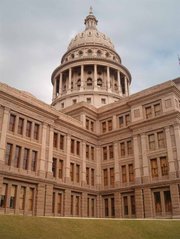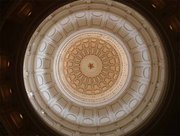Texas State Capitol
|
|
The Texas State Capitol, located in Austin, Texas, is the fourth building to serve as the seat of Texas government. It was constructed from 1882-1888, and a major renovation was completed in the 1990s.
Construction of the capitol building was funded through an article in the state constitution, adopted February 15, 1876, which authorized the sale of public lands for the purpose. The builders of the capitol were paid with three million acres (12,000 km²) of land in the Texas panhandle; this tract later became the XIT Ranch.
The cornerstone for the building was laid on March 2, 1885. The original plan for the capitol called for it to be constructed from limestone quarried within the state; however there was some concern that the available limestone would be of variable quality. Hearing of the problem, the owners of Granite Mountain near Marble Falls offered to donate to the state free of charge the necessary amount of pink granite as an alternative. This stone was subsequently used on the majority of state government buildings in the downtown Austin area, and was called "Texas Pink Granite" until very recently, when those marketing the stone changed the name to "sunset red".
The Texas Capitol was recognized as a National Historic Landmark in 1986.
The capitol has more floor space than any other state capitol building, and is almost 15 feet (5 m) higher than the National Capitol.
Controversy over religious display
TenCommandmentsAustinStateCapitol.jpg
A granite monument of the Ten Commandments on the grounds of the Texas State Capitol is at the center of a U.S. Supreme Court case. Van Orden v. Perry, in which the display is being challenged as unconstitutional, was heard before the supreme court on March 2, 2005. [1] (http://www.washingtonpost.com/wp-dyn/articles/A40461-2005Feb20.html) A decision is expected by late June 2005.
Texasstatecapitol.jpg


